The open science monitor
Launched in 2019, the French Open Science Monitor (OSB) tracks the open access rate of research publications produced by researchers working in a French university or school. A specific tool enables each university to adapt it to its own data.
As part of its policy in favour of Open Science, the Jean Monnet University has adopted this indicator in 2023. For its first edition, the institution's OSB observes the uploads made in 2020 and 2021 for which at least one of the authors is affiliated to the UJM. A few indicators are presented below. You can take a closer look at the Open Science situation at the UJM in the form of graphs on this page, using the following institution identifier: 194210951
Note: the data is extracted from several sources (HAL, Lens and SciFinder): Humanities and Social Sciences are less present in these databases compared to Hard Sciences, so these figures should be treated with caution.
The general monitor
NB: in this first graph, Crossref is a DOI (Digital Object Identifier) registration agency.
Jean Monnet University in Saint-Étienne: Rate of open access to the UJM scientific publications, with a Crossref DOI, published during the previous year, by year of observation.
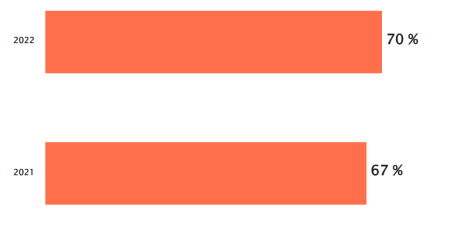
Comment
This graph shows, for each observation date since 2021, the open access rate for UJM scientific publications with a Crossref DOI published during the previous year.
Thus, 67% of UJM scientific publications with a Crossref DOI published in 2020 were open access in 2021 (observation date). And 70% of UJM scientific publications with a Crossref DOI published in 2021 were open in 2022. The access rate has therefore increased by 3 point(s) in just one year.
Data updated on 1 Dec. 2022
Jean Monnet University in Saint-Étienne (UJM): Breakdown of UJM scientific publications, with a Crossref DOI, published in 2021 by opening route (observed in 2022)
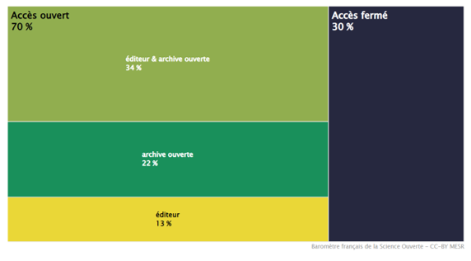
Comment
This graph shows, for the most recent observation date (2022), the repartition of UJM publications, with a Crossref DOI, in open access published during the previous year by opening route. It should be noted that, from one update to the next, an individual publication may change status, for example from "open via publisher" to "open via publisher and open archive" if the publication has meanwhile been uploaded on an open archive.
We can see that, for publications disseminated in 2021, 34% are open via both routes, 22% only via an open archive and 13% only via the publisher.
Openness according to discipline
Jean Monnet University in Saint-Étienne (UJM): Breakdown of UJM publications, with a Crossref DOI, by opening route for each discipline (2021 publications)
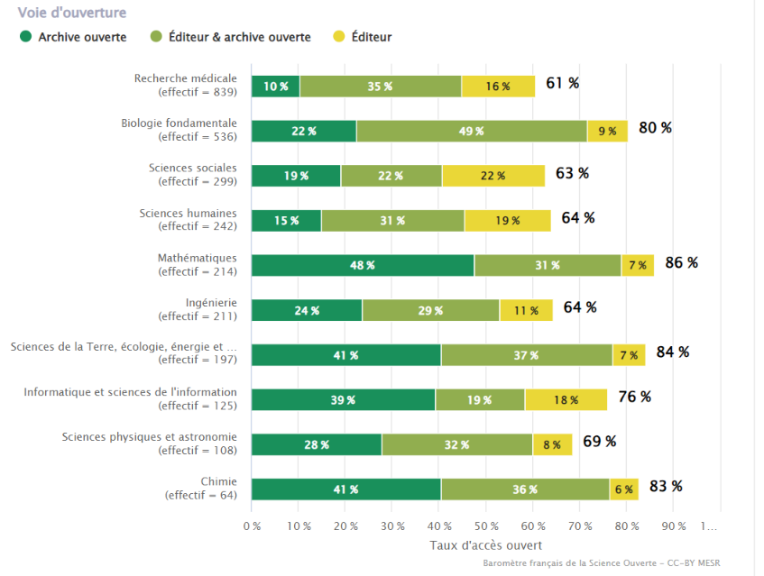
Comment
This graph shows the respective share of the different opening route for each discipline and for each UJM publications with a Crossref DOI, published in 2021 and at the most recent observation date (2022): publication in open access by the publisher, deposit in one or more open archives, or both ways simultaneously.
It should be noted that, from one update to the next, each publication taken individually may change status, for example from "open access via the publisher" to "open access via the publisher and open archive" if the publication has been deposited in an open archive in the meantime. We can see that for publications published in 2021 in medical research, 10% of publications are open via an open archive, 35% are open via the publisher & an open archive and 16% are open via the publisher only.
Jean Monnet University in Saint-Étienne (UJM): Positioning of disciplines according to the preferred routes for opening their UJM publications, with a Crossref DOI, (2021 publications)
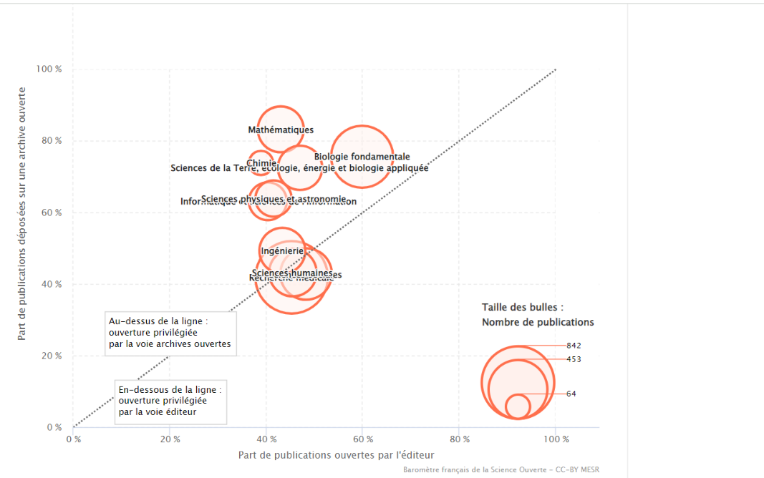
Comment
In this graph, each discipline is represented by a bubble whose size is proportional to the volume of UJM publications, with a DOI Crossref, published in 2021. The position of the bubble indicates the preferred route for opening publications in the discipline concerned: the further to the right the bubble is positioned, the greater the proportion of publications opened by the publisher in that discipline; the further up the bubble is positioned, the greater the proportion of publications deposited in an open archive. When the bubble is positioned at the top right of the graph, this means that publications in this discipline are open simultaneously on the publisher's platform and on one or more open archives. Mathematics, for example, is very keen on open archives, while humanities and social sciences are more willing to entrust their openness to publishers. If the sum of the proportion of publications opened by the publisher and the proportion in an open archive is greater than 100%, this means that some publications are deposited in 2 (or more) places at the same time. There are many situations in between, depending on the organisation and history of each discipline. The most striking fact in this field is the existence of a worldwide policy of systematic deposit in PubMed Central by publishers, which means that these disciplines are open both on publishers' platforms and in a globally used open archive. From the point of view of the National Plan for Open Science, the cohabitation of the two models (openness via publishers and via open archives) presents neither contradiction nor disadvantage. On the contrary, it makes the system resilient.
Licences and open archives
Jean Monnet University in Saint-Étienne (UJM): Breakdown of UJM scientific publications with a Crossref DOI, by type of licence used among open access publications via publishers
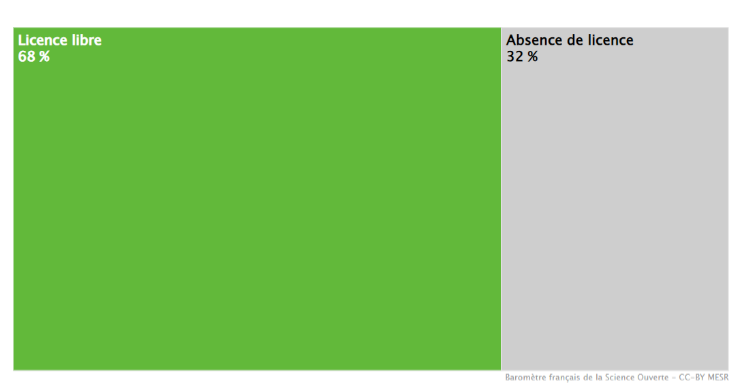
Comment
This graph shows the proportion of UJM scientific publications (with a Crossref DOI, published in 2021 and distributed in open access via their publisher) that are accompanied by a free licence specifying the conditions of re-use. The "See details" button provides a more detailed view of the type of licence used, particularly for Creative Commons licences. It is possible to select a publisher or a publication platform (when several publishers use the same platform, the latter has been favoured).
Thus 68% of UJM scientific publications with a Crossref DOI, published in 2021 and distributed in open access by their publisher, are accompanied by an open licence. Among free licences, the CC-BY licence is the one that is used the most, i.e. for 46% of publications (use the "See details" button).
Jean Monnet University in Saint-Étienne (UJM): Main open archives hosting UJM scientific publications, with a Crossref DOI, published in 2021
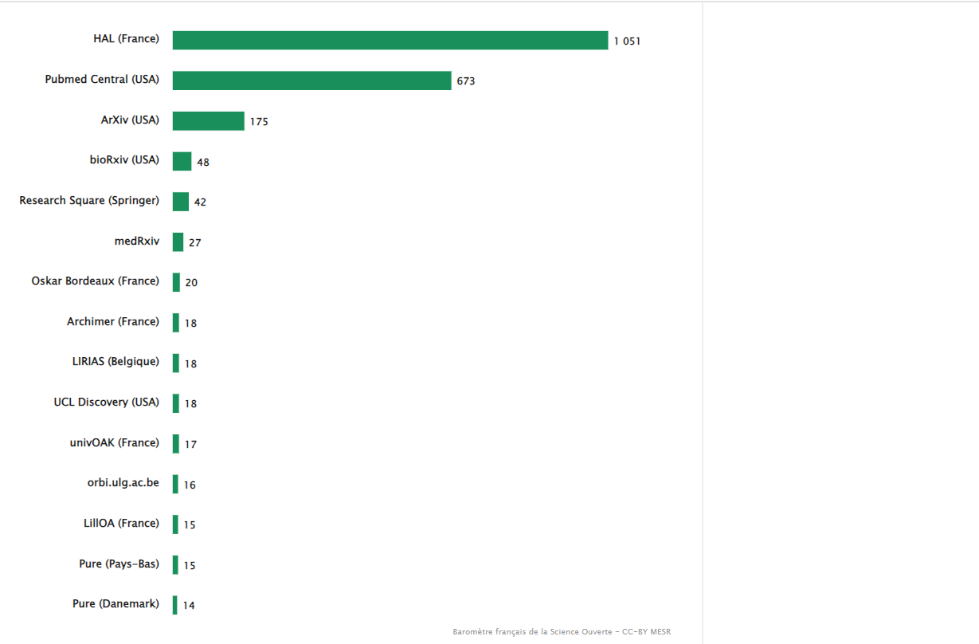
Comment
This graph shows the main open archives hosting UJM scientific publications, with a Crossref DOI, published in 2021, specifying the number of publications concerned for each. When the same publication is deposited on several open archives, it is counted several times.
We can see that HAL (France) hosted 1,051 publications of this area in 2021. The HAL (France) open archive (all disciplines) is therefore the main open archive used for UJM's scientific publications, with a Crossref
DOI, ahead of Pubmed Central (USA) (all disciplines), ArXiv (USA) (all disciplines) and bioRxiv (USA) (all disciplines).
Jean Monnet University in Saint-Étienne (UJM): HAL coverage rate on the scientific publications of UJM, with a DOI Crossref, hosted on an open archive
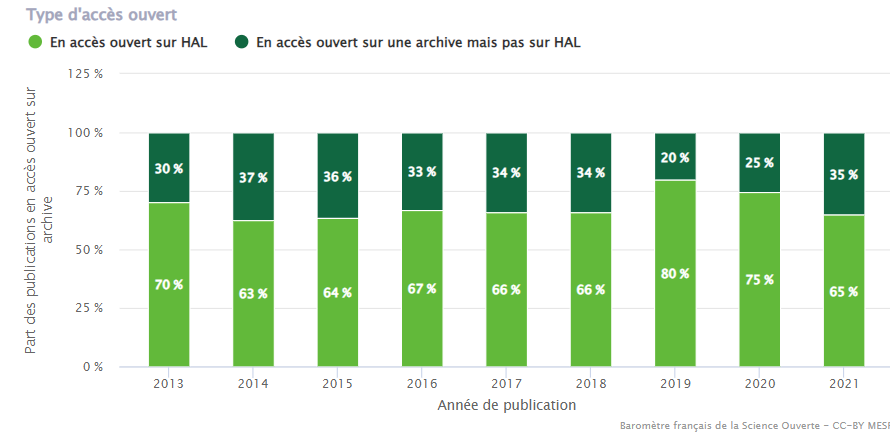
Comments :
HAL is the main open archive used to open French scientific publications. This graph shows the proportion of UJM scientific publications (with a Crossref DOI, hosted on an open archive) hosted on HAL, by year of publication, as observed in 2022.
We can see that among the scientific publications from the UJM, with a Crossref DOI, published in 2021 and open on an archive, 65% are hosted on HAL (and therefore 35% are not hosted on HAL but on one other archive at least).

 Université Jean Monnet
Université Jean Monnet